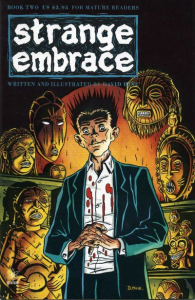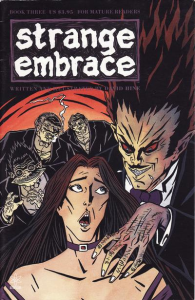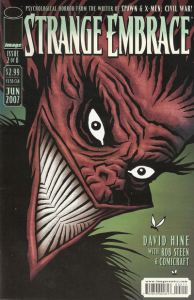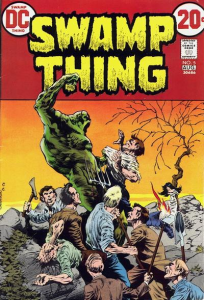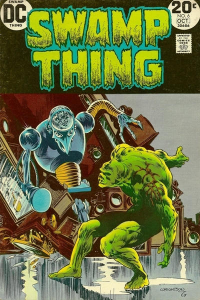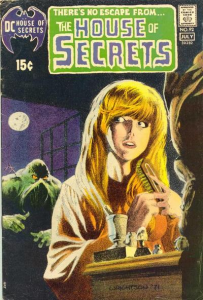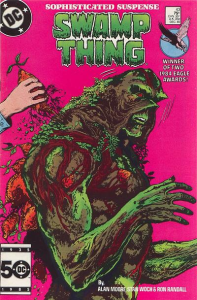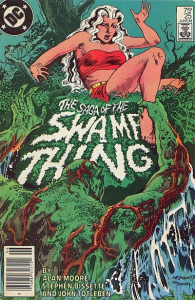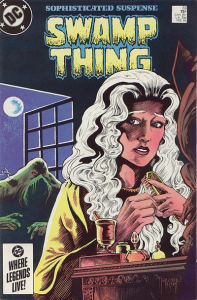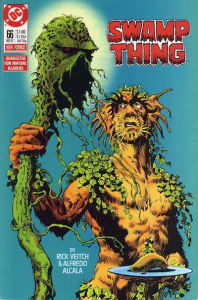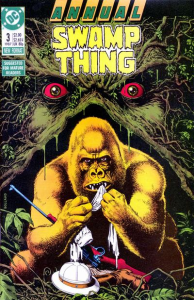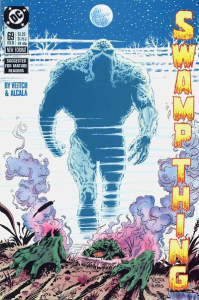If you read the last posts, you know what’s going on. Here are another couple of awesome gothic comics:
STRANGE EMBRACE
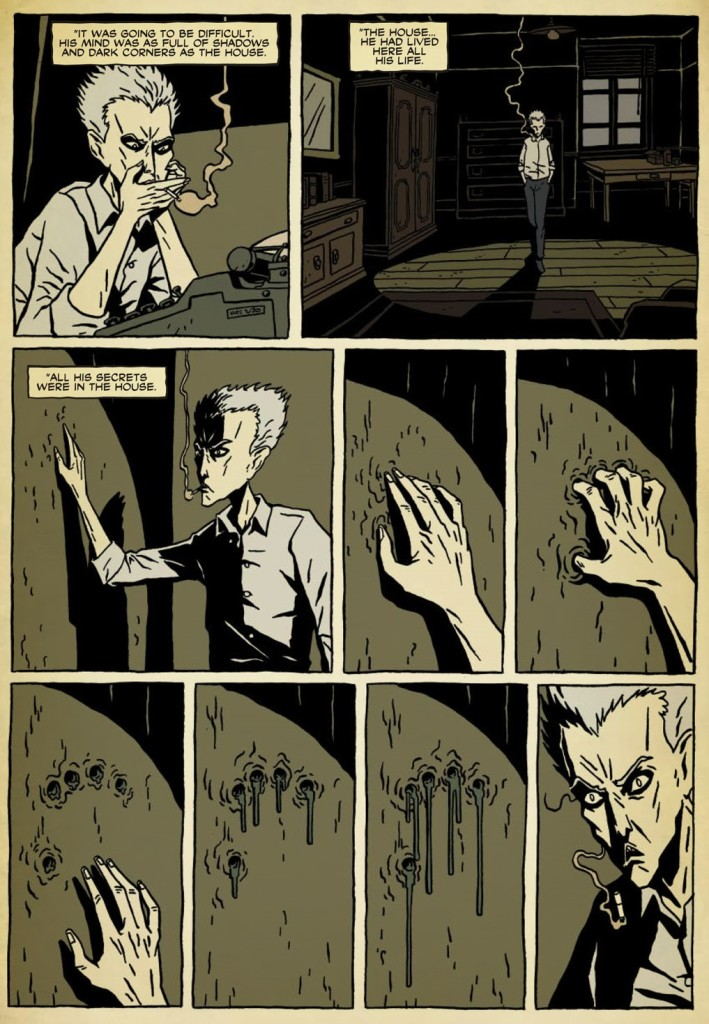 Strange Embrace and other nightmares
Strange Embrace and other nightmares
It’s hard to do justice to David Hine’s nightmarish tour de force, Strange Embrace. There is nothing out there quite like it: Hine intricately weaves layers upon layers of storytelling, covering all the main phobias in the human psyche, from madness to sexual torture to everything in-between. Much of the comic is set in the Edwardian era and, along with more universal themes like alienation or fear of aging, there is a whole subtext about imperial arrogance and European decadence hiding under the guise of Christian civilization.
I’m deliberately keeping things vague because I don’t want to spoil what’s easily one of the sickest plot reveals you’ll ever encounter. But I can assure you that Strange Embrace includes some sequences with insects and a deformed fetus which offer definite proof that Hine is an expert at freaking readers the fuck out.
Hine has written several nifty comics. Many even feature Batman (including the delirious ‘Earthly Delights’). Yet Strange Embrace is his most accomplished work, perhaps because he also illustrated it and there was minimum editorial interference, so we get a very personal vision. Hine’s angular style is suitably odd and you can tell he put a lot of thought into coming up with the most effective ‘camera’ choices. The original art was in black and white, but I own the version colored by Rob Steen, whom I think did a stellar job of maintaining a somber atmosphere throughout the book.
I’ve seen David Hine cite Suddenly, Last Summer as a partial inspiration and I can totally see that. In terms of both content and visuals, I also wouldn’t be surprised to find out this comic was heavily influenced by the films Repulsion, Blue Velvet, and Barton Fink.
SWAMP THING (original era)
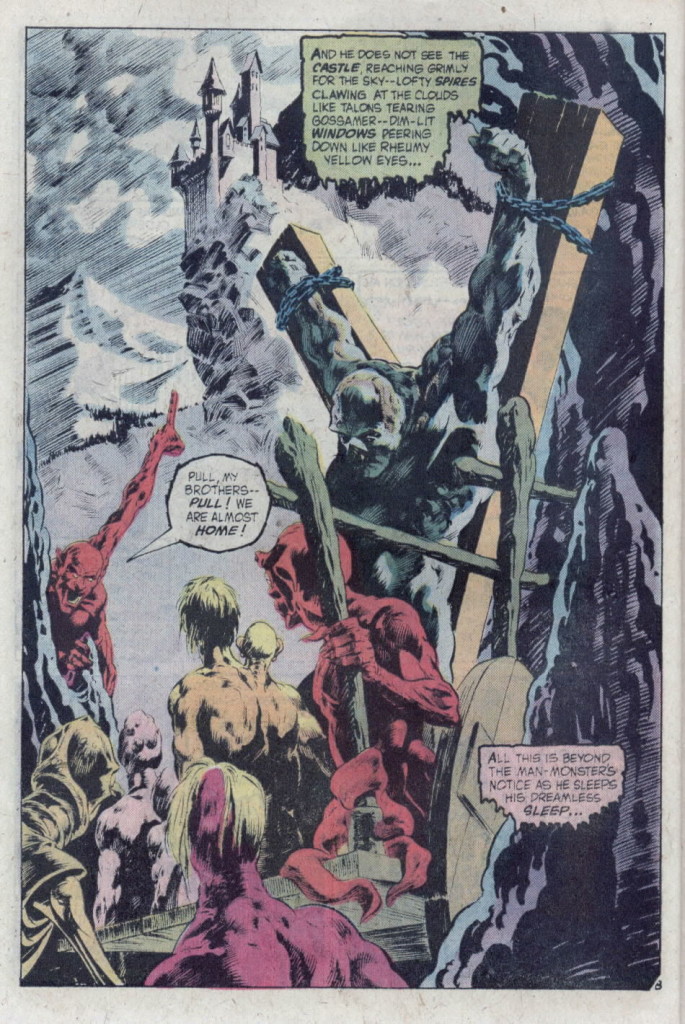 Swamp Thing #2
Swamp Thing #2
Swamp Thing is both one of the best comics of all time and a frustrating case of too-much-of-a-good-thing. DC has stretched a simple concept beyond belief – but in their defense, they have struck gold multiple times! With that in mind, I’ve split this section into three different eras…
The whole thing started with an 8-page story by Len Wein and Bernie Wrightson in the horror anthology House of Secrets #92 (July 1971), about a scientist named Alex Olsen who died in a lab explosion in a swamp and came back as a vegetable monster (i.e. a Swamp Thing). This was a full, standalone tale, but it ended up spawning over forty years of comics!
Wein and Wrightson remade the story as an ongoing series in 1972, with scientist Alec Holland going through a similar transformation. They kept the tragic, gothic tone, but added a serial adventure flair, with Swamp Thing facing classic creatures like werewolves, witches, aliens, and the undead, not to mention the mad scientist Anton Arcane, who became his arch-nemesis. The creators were in top form, with Wrightson delivering his signature haunting art and Wein keeping things moody-as-hell through elaborate purple prose and plots wrought with poetic irony where the most awful monster was, inevitably, humanity itself.
The series kept going even without Bernie Wrightson (starting with issue #11) and Len Wein (issue #14) – and while Nestor Redondo’s, David Michelinie’s, and Gerry Conway’s work isn’t bad, it sure isn’t as memorable. Conway eventually shook things up by reverting Swamp Thing back to a human Alec Holland and briefly making him a supporting character in Challengers of the Unknown, but later everyone agreed that the world would be a better place if we all collectively pretended that the series had ended with issue #20 and anything Conway wrote after that simply didn’t count.
SWAMP THING (Alan Moore era)
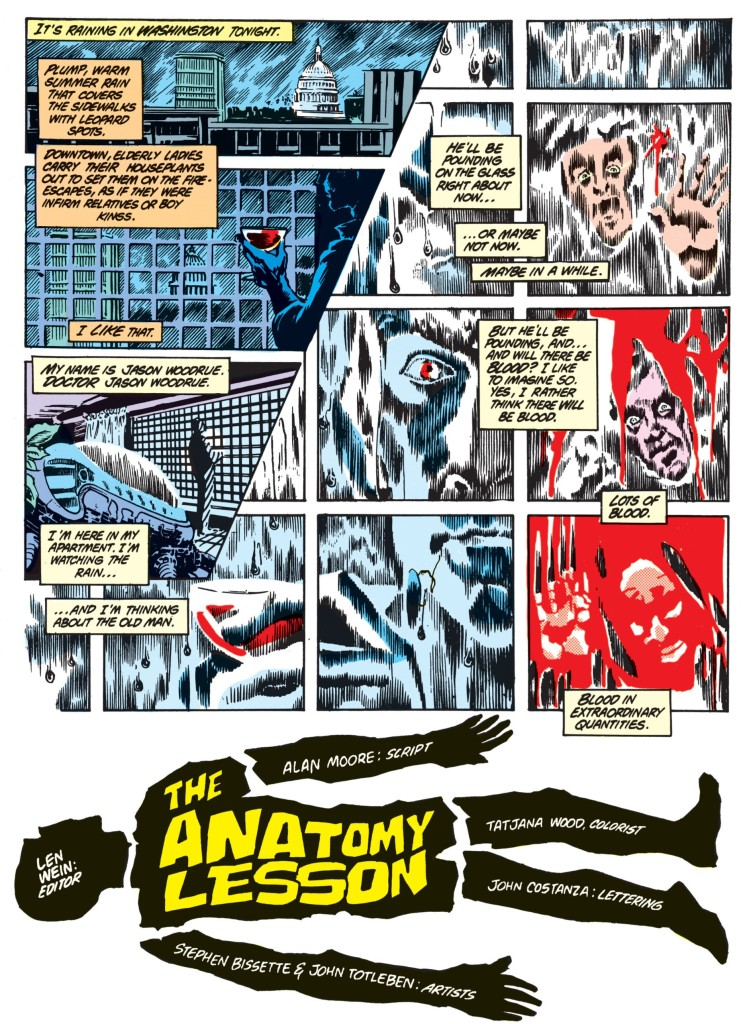 The Saga of the Swamp Thing #21
The Saga of the Swamp Thing #21
Len Wein revived the Swamp Thing property in 1982, this time as editor, presumably to capitalize on the shlocky movie coming out that year (rest in peace, Wes Craven!). Again, Martin Pasko’s scripts weren’t terrible (there were a few neat ideas in there), but he didn’t make a strong case for the universe needing another Swamp Thing series (now pompously titled The Saga of the Swamp Thing). The art was initially by Tom Yeates, who did an OK job, and later by Stephen Bissette and John Totleben, who were of course phenomenal. But the biggest game-changer took place in issue #20, when Alan Moore came in as writer, killed off the protagonist, and changed comics forever.
This isn’t an overstatement. Moore’s run is the stuff of legends – like Watchmen, this is a series that all your favorite writers have read and, to some degree, are likely trying to ape (or perhaps trying to counterbalance). Almost every issue is a mind-blowing classic. ‘The Anatomy Lesson’ (arguably the greatest comic issue ever) revealed that Swamp Thing wasn’t really Alec Holland after all, just a bunch of vegetation that somehow mimicked his consciousness. ‘Roots’ managed to pull off a cameo by the JLA. There was a trio of terrifying issues guest-starring Etrigan, the Demon. The zombie/possession/incest-themed ‘Love and Death’ was the first DC issue in decades to be published without the Comics Code Authority stamp of approval, paving the way for a line of mature-oriented series (which later became the Vertigo imprint). ‘Down Amongst the Dead Men’ (in which Swamp Thing travelled to Hell, meeting Deadman and the Spectre along the way) and ‘Abandoned Houses’ (which incorporated the original House of Secrets short story into the continuity) pretty much set the blueprint for the corner of the universe Neil Gaiman would develop in The Sandman. ‘Pog’ was a sweet homage to Walt Kelly’s Pogo. ‘Rite of Spring’ showed Swamp Thing and Anton Arcane’s niece, Abigail, having hallucinogenic sex. The list goes on.
In the background of the series’ self-professed ‘sophisticated suspense’ was the fact that the eighties were a pretty scary time, socially and politically, which may explain the overall boom of horror fiction providing cathartic metaphors for that era’s anxieties. This was never clearer than in the ‘American Gothic’ arc, which used horror tropes to address topical issues like pollution, sexism, racism, and gun culture. This arc also introduced beloved cast members, including John Constantine and the aging hippie Chester Williams. Plus, it explained that the Swamp Thing was in fact a plant-based Earth Elemental created by the Parliament of Trees. Plus, there was a brief crossover with Crisis on Infinite Earths. Oh, and the climax pretty much redefined the concepts of Good and Evil in the DC Universe. And what did Alan Moore do after that? He had Swamp Thing destroy Gotham City. And after *that* he sent Swampy into space, giving the Moore-treatment to DC’s extraterrestrial characters.
The impact of Alan Moore’s run was felt across the DC Universe. Hellblazer, Black Orchid, The Sandman, and Books of Magic all have clear ties to Moore’s work. The elemental-based mythology found its way into Firestorm and Animal Man, among many others. And, memorably, traces of Swamp Thing’s space travel showed up in both James Robinson’s Starman and John Ostrander’s Martian Manhunter.
SWAMP THING (post-Moore era)
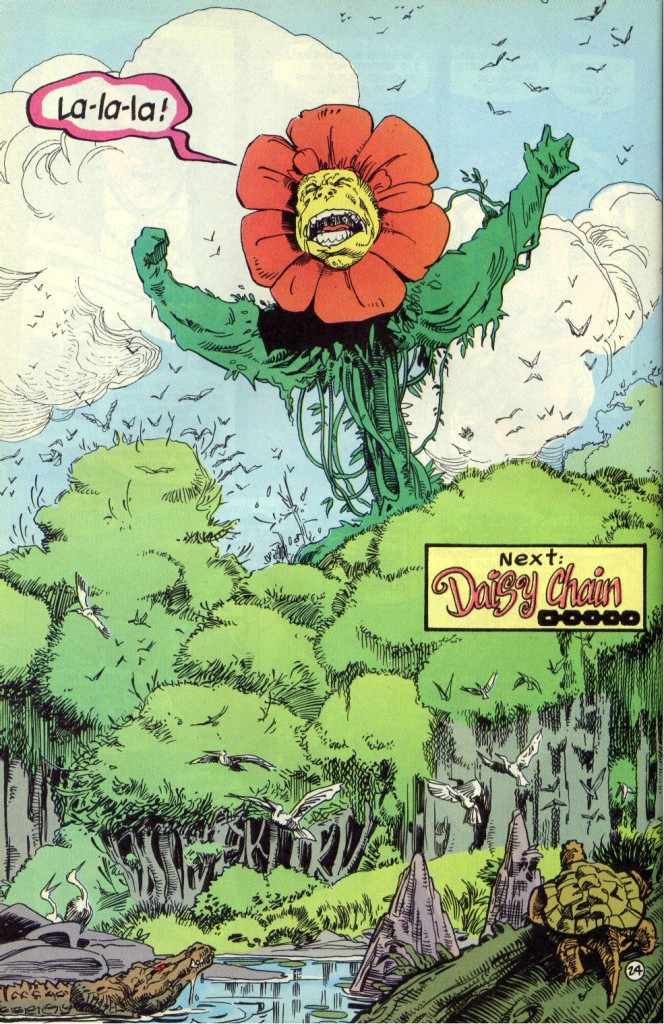 Swamp Thing #132
Swamp Thing #132
You’d think Alan Moore would be an impossible act to follow, but this wasn’t the case. Rick Veitch, who along with Bissette, Totleben, and Stan Woch had been killing it on the art, became the series’ regular writer and kept Moore’s literary standards as well as countercultural sensibilities while bringing in his own brand of psychedelic satire. The first part of Veitch’s run concerned an attempt to find a host body for Swamp Thing’s replacement (which the Parliament of Trees had generated while Swamp Thing was in outer space), a storyline that was neatly resolved in a fabulous crossover with Hellblazer. The second part saw Swamp Thing travel through time, meeting DC characters from various eras, and was supposed to have culminated in a meeting with Jesus Christ but the publisher pulled the plug at the last moment, leading to Rick Veitch’s resignation.
Say what you want about Doug Wheeler, he did a solid job of wrapping up Veitch’s plot threads, and even wrote a few nice isolated tales (I quite like ‘La Terre qui Disparait’) before getting bogged down into an endless, uninspired saga pitting Swamp Thing’s Elemental dimension (the Green) against a fungus-based one (the Gray). The loss of momentum carried over into Nancy A. Collins’ run, which is a shame because there are plenty of cool moments in that run (plus a couple of very strong fill-ins by Dick Foreman). The problem is that Collins focused on Swamp Thing’s family dynamics (by then Swampy was living with Abigail and they had a daughter, Tefé), turning the comic into a horror soap opera. While this was sometimes fun, it further sucked the inspiration out of the series’ most outlandish elements, as plant creatures, Swamp Thing’s kinky sex life, and the same old villains became increasingly mundane.
A much needed breath of fresh air came in the form of Grant Morrison’s and Mark Millar’s closing run, which knocked down everything in its path. Finally coming to terms with the full implications of ‘The Anatomy Lesson,’ Swamp Thing gave up his humanity, took over all the Elements, became the most powerful being in the planet, and eventually became the Earth itself. Although a bit uneven, this run delivered the epic finale the series deserved!
Comics being comics, this wasn’t the end. Writer Brian K. Vaughan was given another series in 2001, which was hit-and-miss but at least had the good sense to leave Swamp Thing alone and instead focus on Tefé Holland, his daughter. The same can’t be said for the 2004 Swamp Thing series nor for the 2011 reboot, which kept recombining the same characters and concepts without realizing that – Challengers of the Unknown aside – the franchise had always been at its best when breaking new ground and going in unexpected directions.
Also, there totally was a Swamp Thing cartoon, which was ama-zing.

